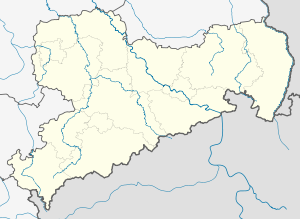Lockwitztal Bridge
Coordinates: 50 ° 58 ′ 43 " N , 13 ° 47 ′ 40" E
|
|
||
|---|---|---|
| The Lockwitztal Bridge. You can see the three pillars with the arches. | ||
| use | Highway bridge | |
| Convicted | Federal motorway 17 | |
| Crossing of | Lockwitzbach | |
| place | Dresden | |
| construction | Composite steel bridge | |
| overall length | 723 m | |
| height | 64 m | |
| building-costs | € 32 million | |
| start of building | Summer 2002 | |
| opening | December 13, 2005 | |
| location | ||
|
|
||
The Lockwitztal Bridge in the southeast of Dresden is the longest of the eleven large bridges on the four-lane Autobahn 17 from Dresden to Prague . It spans the valley of the Lockwitzbach near Dresden- Lockwitz .
description
The double bridge with two superstructures is 723 meters long, has eight piers and spans of 48 m + 60 m + 65 m + 70 m + 85 m + 125 m + 125 m + 85 m + 60 m, with which it connects the Lockwitztal in crossed a maximum height of 64 m. In the ground plan it has a circle radius of 2500 m. The cross slope is 3.5%. The 3.0 m high carriageway girder is a composite steel box girder, the 6.5 m wide lower chord is an open U-section made of steel. The arches, deck and pillars are made of reinforced concrete .
The bridge looks like an arched bridge, but the semi-arch below the road acts like a diagonal strut (analogous to the headband in the roof structure), the horizontal forces of which are in balance with the opposite semi-arch due to the superstructure.
The bridge should have as few pillars as possible so as not to disturb the fauna and flora habitat in the valley of the Lockwitzbacheses. For this reason, an arch system was arranged between the three columns with the largest spans to support the superstructure. On these three main pillars, 50 m long semi-arches are anchored to the right and left in the superstructure like arms. The arches have a cross section of 5.5 m × 1.6 m and a circle radius of 140 m. They are rigidly connected to the pillars and the superstructure. In addition to absorbing tensile forces the sheet halves 10 were tendons without bond, the 3 MN clamping force and in the box girder disposed mutually hung back. The semi-arches do not meet at the apex, but together with the superstructure they form a so-called arch bridge that is anchored in itself (in the superstructure) .
The assembly and insertion of the steel box using the incremental launching method was carried out from one side. Additional auxiliary supports were erected in the four large fields. The construction of the arches took place after the slot on the pillar always symmetrical on both sides with a re-transferred to Hilfsabspannungen cantilever and a high hung on the superstructure formwork . This enabled the stress and deformation of the pillars to be minimized. The steel box girder, in which lines for energy and sewage are also housed, lies on the pillars. It is closed at the top by the reinforced concrete deck.
The structure of the three arch-bearing pillars is a monolithic frame that braces the bridge. The deformations of steel and concrete due to temperature changes and traffic loads are compensated in lateral sliding bearings. On the five pillars without arches, horizontally movable bearings are arranged. The four northern piers are built up to 13 m deep on bored piles , the remaining piers have a shallow foundation.
Construction phase
The project was planned by the engineering office Leonhardt, Andrä und Partner .
Construction of the bridge began in the summer of 2002. At the end of the year the first pillars were ready. First the north side of the bridge was built. The bankruptcy of the concrete construction company in early 2004 led to a six-month delay in construction. The first part of the bridge was opened to traffic on July 22, 2005, and the second (southern) half of the bridge followed on December 13, 2005. The construction costs amounted to 32 million euros .
The construction of the bridge claimed a human life, a construction worker was crushed during the assembly work.
The Lockwitztal Bridge received the “Award for Transportation Structures 2008” from the Institution of Structural Engineers.
literature
- Reintjes, Karl-Heinz: The arched bridges of the A17 - design and execution . Bautechnik 82 (2005), issue 11.
See also
Web links
- Lockwitztal Bridge. In: Structurae
- brueckenweb.de information
- Construction site photo ( Memento from September 7, 2004 in the Internet Archive )
- 3sat: Bridge construction as a construction and statics masterpiece ( Memento from September 30, 2007 in the Internet Archive ) Note: After loading, if JavaScript is activated, an error page will be forwarded.
Individual evidence
- ^ Peter Hilbert: Dresden bridges . From the beginning to the present. 1st edition. edition Sächsische Zeitung, Dresden 2014, ISBN 978-3-943444-39-1 , Lockwitztalbrücke, p. 150-151 .



